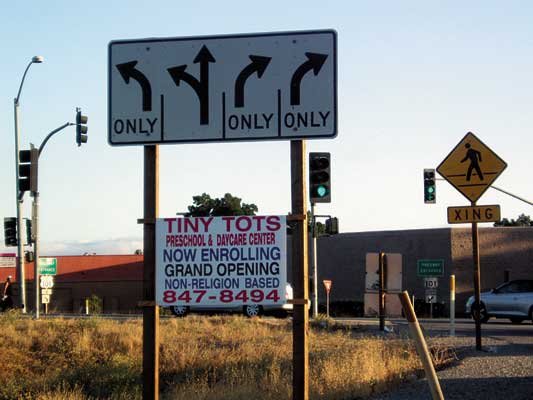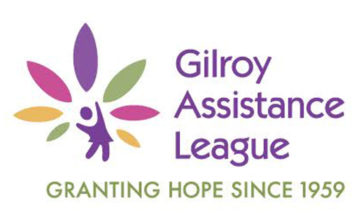Amador and Brianna Leal just wanted to get the word out about
their new day care center.
Amador and Brianna Leal just wanted to get the word out about their new day care center.
The entrepreneurial couple went about it the best way they and businesses across the world know how: They put up signs. They paid $100 for each Tiny Tots ad and placed them on medians, attached them to street signs along roads and near intersections, attracting the attention of tens of thousands of residents and regular commuters.
“Posting signs was the best way to go about it,” Amador Leal said. “We’re just trying to get the word out because this is a new business, but I know I’m taking a chance.”
That’s because Gilroy has 14 pages worth of sign regulations, and chief among them is this prohibition: no signs on any curbstone, lamppost, pole, hitching post, hydrant, bridge or tree upon a public street or public property within the city.
But even permitted signs can be too close to the curb or too big, they can obstruct pedestrians or the view of drivers, they can be placed illegally on landscape mounds or too far away from the business, amongst other violations. Businesses can have a portable, non-electrical, 2-and-1/2 by 4-foot wood sign on the public sidewalk outside their store front only if the business is open, the sign has insurance and pedestrians can walk freely. Oh, and no balloons.
“But there’s no sense in making these rules if we can’t enforce them. The sign ordinance is just being widely ignored,” Councilman Perry Woodward said. “It’s a little bit like if everyone in town didn’t stop at red lights: It would be difficult to get that problem under control. He added that the city’s web of regulations amount to little without vigilance on the city’s part.
“There needs to be more stringent enforcement,” Woodward said, “but our enforcement folks are spread too thin and don’t work on the weekends.”
Officials chafed at those neon rectangular signs on lights posts advertising gun shows and tattoo exhibitions at the county fairgrounds or up in San Jose. Those promoters likely post their signs during nights and on weekends when the city’s two code enforcement officers are off the job, and council members worry that an all-out free-for-all could happen soon if known violators go unpunished.
“It starts out small and then it progresses,” Councilman Dion Bracco said. “They put them up on light poles and on people’s properties, and they never come back to get them … We’re not addressing it. We continue to only address issues on a complaint basis, but city employees need to start reporting them more and not wait for citizens to get fed up and start complaining.”
Amador Leal never received a warning, citation or fine for his infraction, and he said he removed his signs recently because Tiny Tots, at 8531 Church St., kicked off its first year June 1 with plenty of enrollees. Code Enforcement Officer Scott Barron did not receive any complaints about the Leals’ signs either, but he did pick one up off a median near 10th Street, he said. Barron did not return messages Thursday seeking the number of citations and amount of fines issued this year, but he said in an earlier conversation that the level of violations this year appears “average.”
For those who do post outlawed signs, “If they’re not removed or if there is a recurrence, then there’s a very good chance we’ll issue a citation,” Barron said.
A 10-day warning precedes any citation, though, and first-time violators can get slapped with $100 fine; $200 for the second time, $500 for the third, and up to $1,000 and six months in jail for further violations. Hence the chance Amador Leal spoke to. But the man who formerly worked along the downtown corridor and said he understood the city’s complicated sign code, also said, “The city understands itself how businesses need the signs to drum up business.”
Especially in a down economy, City Administrator Tom Haglund said.
“As economic times get tougher, there tends to be more of a proliferation of business related signs in the public right of way,” Haglund said. “It’s a problem everywhere.”
The city council as a whole discussed the issue during a study session in May, when Rosso’s Furniture owner and Gilroy Unified School District Board of Trustees member Jaime Rosso expressed frustration that his business was playing by the rules while nearby competitors flouted sign codes and hung huge banners and placed signs on public property near the freeway and such.
Rosso did not go as far as one Hanford citizen. There, one resident repeatedly showed up at city council meetings with a bundle of signs he spent the weekend collecting because the city was not, according to Haglund, Hanford’s former deputy manager.
“It was his point that the sign issue is irksome to a lot of people,” Haglund said with a chuckle.
While signs may annoy drivers and distress city employees, they attest to the region’s commerce amid tough times – something the city council will consider in the absence of a weekend crusader sweeping Gilroy’s streets.















